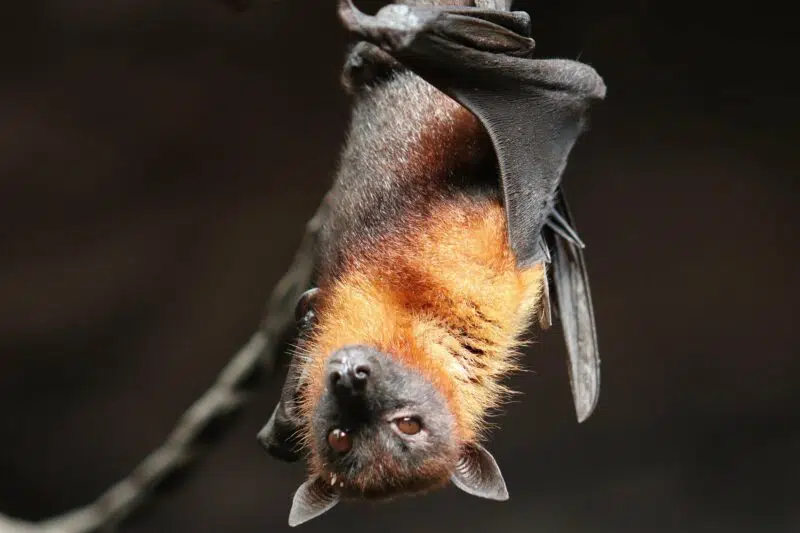Welcome to 10 Cave Animals.
Beneath the Earth’s surface lies a mysterious realm, one where the rules of nature seem to take on a whole new dimension. Caves, especially those that plunge to extreme depths, harbor ecosystems that stand in stark contrast to the world outside. Within these subterranean chambers, a constant temperature prevails throughout the year, creating an environment unlike any other.
What makes this underground world even more intriguing is the presence of cave-dwelling creatures, which have adapted to this harsh and isolated environment over countless centuries. These remarkable organisms, known as “troglobites” in the world of experts, evoke a sense of wonder and fascination. Some species are so extraordinarily unique that only a handful of individuals exist within a specific cave system.
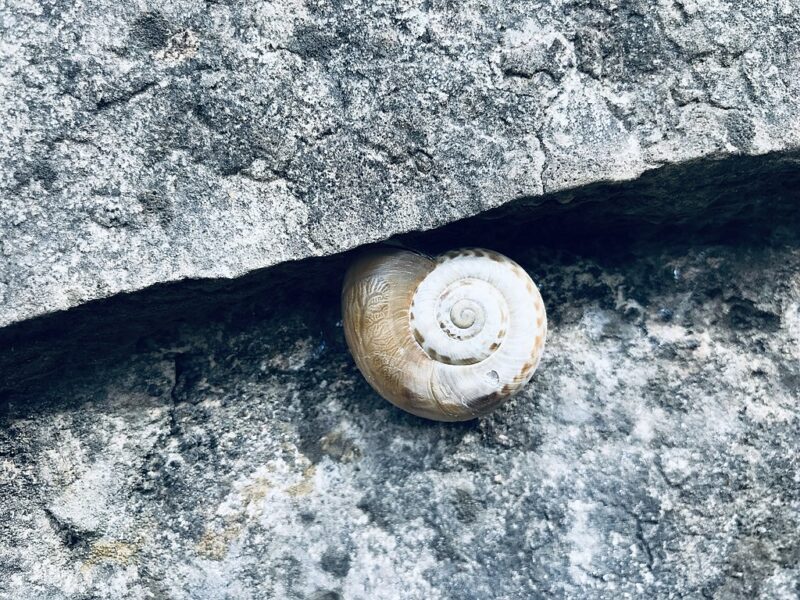
In this article, we will embark on a journey into the enigmatic world of cave ecosystems, shedding light on the captivating adaptations and life forms that have evolved in the depths of the Earth. Prepare to be amazed by the secrets concealed beneath the ground and the incredible stories of survival that unfold in the shadows of the subterranean world.
Read the entire article or jump to any section you want.
Key Points
| # | Animal Name | Key Information |
|---|---|---|
| 1 | Bat | – Bats are important for pollination and insect control. – There are around 1,400 bat species worldwide. |
| 2 | Bear | – Bears are carnivores and omnivores found in various environments. – They play cultural roles in human communities. |
| 3 | Swiftlet | – Swiftlets are found in tropical and subtropical regions. – They use echolocation for navigation in caves. |
| 4 | Olm | – Olms are aquatic salamanders adapted to life in complete darkness. – They rely on other senses besides vision. |
| 5 | Cave Pseudoscorpion | – Pseudoscorpions are small arachnids that prey on pests. – They can be mistaken for ticks or tiny spiders. |
| 6 | Kaua’i Cave Wolf Spider | – These spiders are blind and found only in specific Hawaiian caves. – They have unique reproductive behaviors. |
| 7 | Cave Harvestman | – Cave harvestmen are troglobites with long legs and are blind. – They are adapted to cave environments. |
| 8 | Tumbling Creek Cave Snail | – These snails are aquatic troglobites living in cave waters. – They are sensitive to water quality changes. |
| 9 | Devil’s Hole Pupfish | – Devil’s Hole pupfish are severely endangered and live only in a Nevada cave. – They have a limited diet. |
| 10 | Cave Crayfish | – Cave crayfish are small, white, and live exclusively in caves. – They have unique reproductive behaviors. |
What are cave Animals?
These are cave-dwelling creatures. They frequently fall into caverns as a result of the dripping water. The following sections will go through each of these categories.
Because a significant number of underground caves have yet to be studied, many cave-dwelling species are still unknown. Even though the interiors of deep caverns are typically linked with calm ecosystems, there are still significant hazards to animals that live there.
Troglofauna are animals that have evolved to dwell in caves. For example, bats, bears, and swiftlets occupy caves on a short-term basis. Others live there indefinitely, spending their whole lives in the dark – yet many have developed extraordinary talents to enable them to survive in their food- and light-scarce environments.
#1 Bat
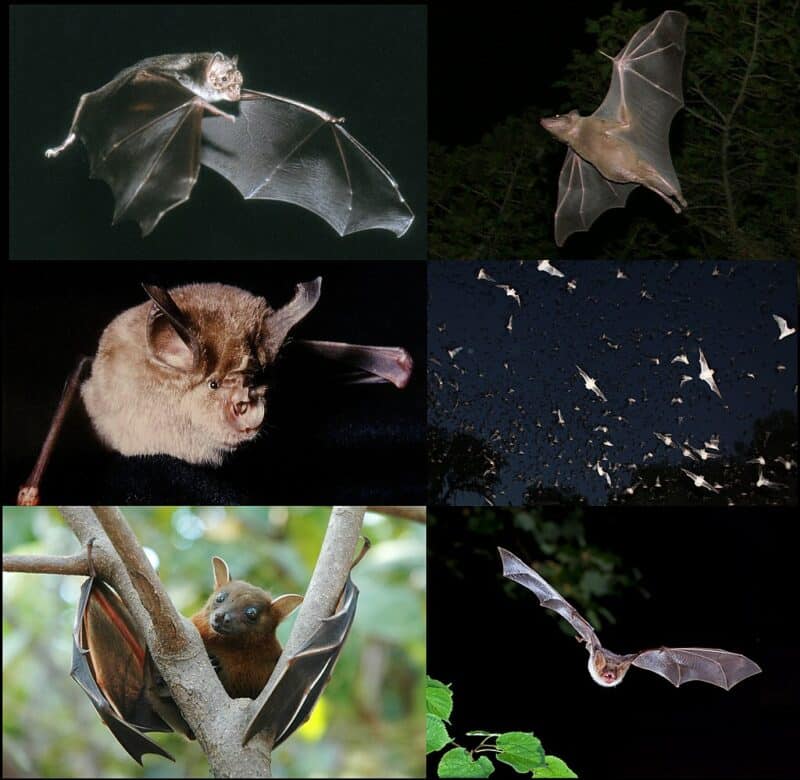
| Property | Value |
|---|---|
| Scientific Name | Chiroptera (Order) |
| Average Size | Varies by species |
| Diet | Insects, fruit, nectar, or blood (species-dependent) |
| Special Features | Nocturnal, echolocation, diverse species |
When delving into the captivating world of cave-dwelling creatures, it is impossible to begin without paying homage to the undisputed champions of the underground realm—bats. Often shrouded in myths and misconceptions, bats are not only fascinating but play crucial roles in our daily lives, roles that often go unnoticed.
Bats emerge as nocturnal heroes, silently pollinating our beloved fruits, tirelessly combating troublesome insects, and even inspiring groundbreaking medical breakthroughs. They stand as the only creatures capable of genuine and sustained flight, thanks to their uniquely adapted forelimbs transformed into wings.
Bats navigate the night sky with remarkable agility, propelled by their wide-spread fingers enveloped in a delicate patagium membrane, making them more nimble than many birds. Among these winged wonders, Kitti’s hog-nosed bat takes the crown as the tiniest extant animal, measuring a mere 29–34 millimeters in length, boasting a wingspan of 150 millimeters, and weighing a featherlight 2–2.6 grams. On the flip side, the flying foxes, the giants of the bat world, include the impressive Malayan flying fox, reigning supreme as the largest.
With approximately 1,400 distinct species scattered across the globe, bats prove to be remarkably adaptable. You can encounter these remarkable creatures in nearly every corner of the world, save for the icy extremes of polar caps and the unforgiving desolation of extreme deserts. Their diversity is nothing short of astounding.
Bats showcase an astonishing range in size, from the diminutive Kitti’s hog-nosed bat, known as the Bumblebee Bat, weighing less than a penny, to the grandeur of flying foxes, boasting wingspans that can stretch up to a remarkable 6 feet. Within the United States and Canada alone, around 45 bat species call these regions home, with additional species residing in U.S. territories in the Pacific and Caribbean.
#2 Bear
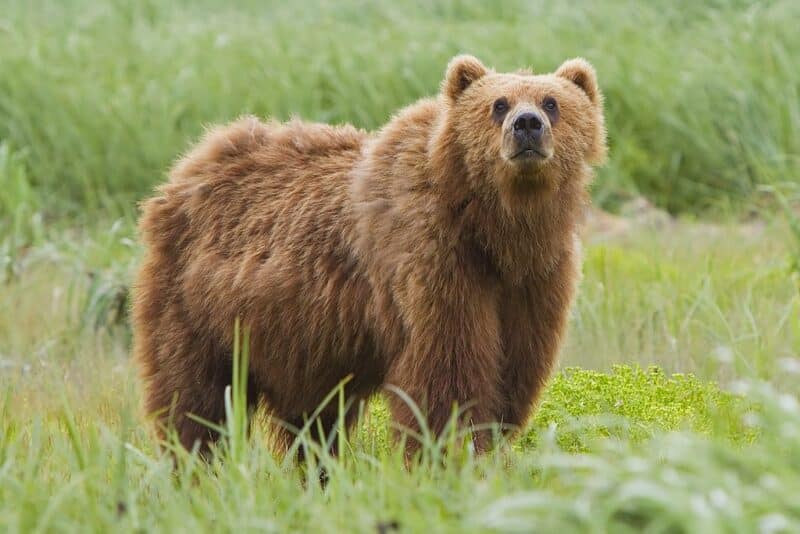
| Property | Value |
|---|---|
| Scientific Name | Ursidae (Family) |
| Average Size | Varies by species |
| Diet | Omnivorous (plants, berries, fish, small mammals) |
| Special Features | Hibernation, strong and adaptable |
Bears come from the Ursidae family of carnivores. Caniforms, or doglike carnivorans, are their classification. Bears are found in various environments in the Northern Hemisphere and partially in the Southern Hemisphere, even though only eight species are known to exist.
Bears could be located in the continents of Asia, Europe, South America, and North America. Large bodies with stocky legs, prominent snouts, tiny rounded ears, messy hair, plantigrade feet with five nonretractile claws, and short tails are all common traits of contemporary bears.
The polar bear is mainly carnivorous, while the giant panda eats nearly solely bamboo, but the other six species are omnivores and eat various foods. Bears are mainly solitary creatures, except for courting individuals and moms with their offspring.
Bears can be energetic at any time of day or evening and have a strong scent of smell. Although their girth and lumbering stride, bears are capable swimmers, climbers, and runners. Bears create their dens out of caverns and logs, and most species hibernate in their dens for up to 100 days throughout the winter.
Encroachment on bear habitats and illicit trading in bear parts, such as the Asian bile bear market, have threatened bears recently. Six bear species are classified as vulnerable or endangered by the IUCN, and even species classified as least concerned, such as the brown bear, are threatened with extinction in some nations. Poaching and foreign trading of these most vulnerable species are illegal, yet they still happen.
#3 Swiftlet
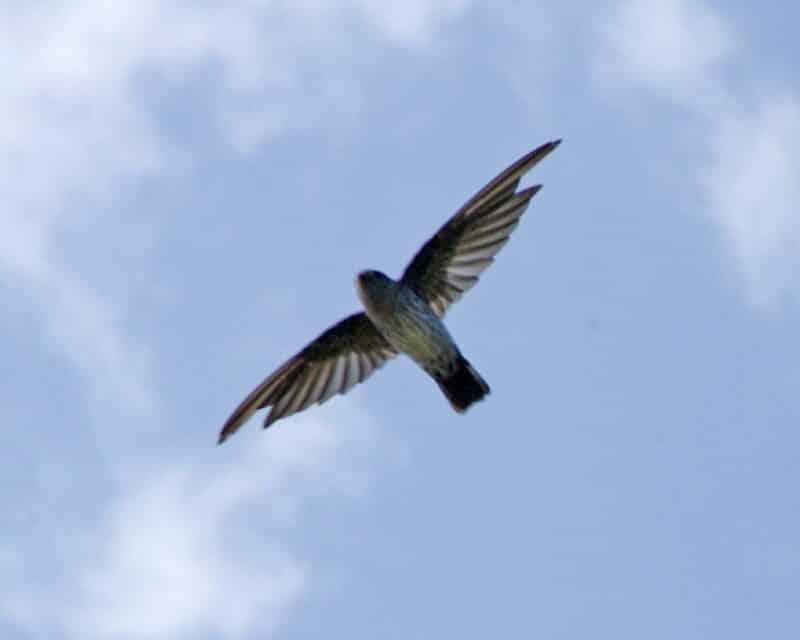
| Property | Value |
|---|---|
| Scientific Name | Aerodramus spp. |
| Average Size | Small (10-12 cm) |
| Diet | Insects and small arthropods |
| Special Features | Edible bird’s nests, found in caves |
Swiftlets are cave animals that belong to the Aerodramus, Hydrochous, Schoutedenapus, and Collocalia genera. Within the swift family Apodidae, they belong to the Collocaliini group.
Around thirty species are found in southern Asia, the South Pacific islands, and northeastern Australia, all in tropical and subtropical environments. They have thin wings for quick flying, a prominent gape, and a little reduced mouth covered by bristles for collecting insects in flight, and they are Apodidae members in many ways.
Many, but not all, swift species, and indeed practically all other birds, are distinguished by their ability to navigate in utter darkness through the chasms and shafts of the caves where they sleep at night and nest, using a basic but efficient kind of echolocation.
Some species’ nests are made of saliva threads, harvested for the famed Chinese dish bird’s nest soup.
Guano from the swiftlets and the cave’s numerous bats nourishes a diverse range of specialized species that feed on the feces. Snakes that can scale vertical cliffs to snare a passing meal and gigantic predatory insects that prey on chicks and bat pups are among the other species that have evolved to feed on these dung eaters as well as the bats and swiftlets themselves. The only connection from the outside seems to be the bats and birds that transport the nutrition into the caverns in the first place.
#4 Olm
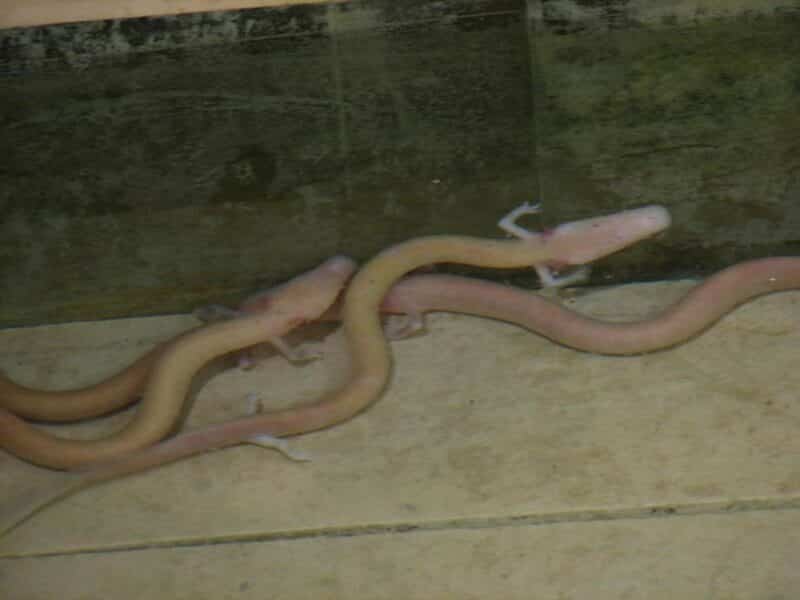
| Property | Value |
|---|---|
| Scientific Name | Proteus anguinus |
| Average Size | 20-30 cm |
| Diet | Carnivorous, preys on small aquatic invertebrates |
| Special Features | Blind, aquatic salamander living in caves |
The olm or proteus (Proteus anguinus) is a dungeon aqueous salamander of the Proteidae family and our 4th member of this top 10 cave animals list . It is Europe’s sole dungeon chordate species. It is aquatic, unlike other amphibians, and feeds, sleeps, and reproduces underwater.
This cave salamander is known for its ability to adapt to life in full darkness in its underground environment. The olm’s eyes are underdeveloped, leaving it blind, but its other senses, especially smell, and hearing, are well-developed. Its skin is similarly devoid of pigmentation. Its forelimbs have three toes, while its hind foot only has two.
Like several American amphibians, such as the axolotl and mudpuppies, it also shows neoteny or the retention of larval traits like external gills until maturity (Necturus). The olm is the only species in the Proteus genus and the only European species in the Proteidae family, including the extinct genus Necturus.
Cave animals have been encouraged to evolve and strengthen non-visual sense systems, among other adaptations, to orient in and adapt to permanently dark surroundings. The sensory system of the olm has likewise evolved to cope with living in the underground aquatic environment.
Because it can’t utilize eyesight to navigate, the olm relies on other senses, which are more developed than in surface-dwelling amphibians. It preserves larval characteristics such as a long, thin body and a broad, flattened head, allowing it to carry more sensory receptors.
#5 Cave Pseudoscorpion
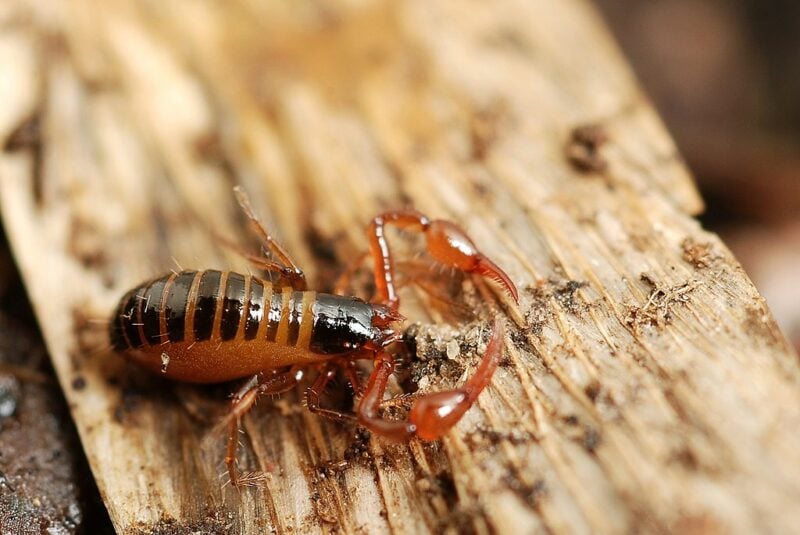
| Property | Value |
|---|---|
| Scientific Name | Various species |
| Average Size | Tiny (< 5 mm) |
| Diet | Small insects and arachnids |
| Special Features | Arachnid resembling scorpions without a tail |
In our exploration of the top 10 cave-dwelling creatures, we encounter an unlikely hero – the pseudoscorpion. These tiny arachnids may seem inconspicuous, but their role as voracious predators is anything but ordinary.
Pseudoscorpions, often mistaken for ticks or miniature spiders, are typically the unsung saviors of our homes. They dine on a menu that includes clothes moth larvae, carpet beetle larvae, booklice, ants, mites, and minuscule flies. Their penchant for these pests makes them invaluable allies to humans. Despite their abundance in various habitats, their diminutive size often renders them unnoticed.
Belonging to the Arachnida family, pseudoscorpions sport a flattened, pear-shaped body and distinctive scorpion-like pincer-like pedipalps. Their average length ranges from 2 to 8 mm, although the notable Garypus titanium from Ascension Island reaches up to an impressive 12 mm. Typically, they measure around 3 mm. The number of fused segments in their eight legs, each boasting five to seven segments, distinguishes different families and genera of pseudoscorpions.
Their most striking feature is the two long pedipalps armed with palpal chelae, resembling miniature scorpion pincers. These pedipalps consist of an immovable “hand” and a movable “finger,” manipulated by the adductor muscle.
Most pseudoscorpions fall under the Iocheirata clade, featuring a venom gland and duct within the movable finger. This venom plays a critical role in paralyzing their prey. During digestion, pseudoscorpions release a mildly caustic fluid onto their quarry, dissolving it into a digestible form. These fascinating creatures then feast on the liquefied remnants of their conquests.
#6 Kaua’i Cave Wolf Spider
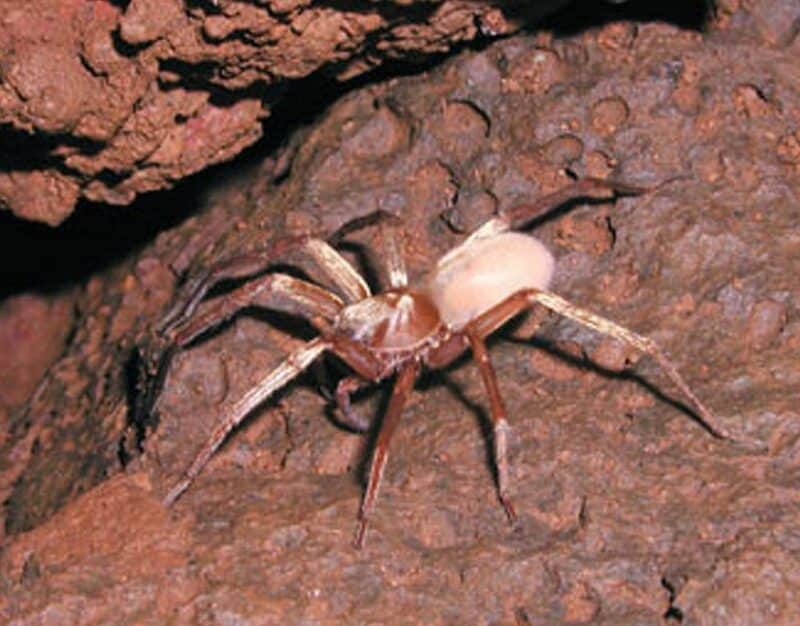
| Property | Value |
|---|---|
| Scientific Name | Adelocosa anops |
| Average Size | 1 inch (2.5 cm) |
| Diet | Carnivorous, preys on insects |
| Special Features | Endemic to caves on Kaua’i, Hawaii |
The Kauai cave wolf spider (Adelocosa stops, the sole species in the genus Adelocosa), locally referred to as the “blind spider,” exists exclusively within a few caves situated within a 10.5 km2 lava flow in the Kloa–Poip region of Kauai, Hawaiian Islands. There are only six known populations of this species.
In contrast to its surface-dwelling relatives, this species has completely lost its eyes. It attains a length of approximately 20 mm, sporting a reddish-brown coloration, and poses no threat to humans. Unlike other wolf spiders, it produces only 15 to 30 eggs per clutch. The female carries the egg sac in her mouthparts until the spiderlings hatch.
One of its primary prey species is the Kauai cave amphipod, Spelaeorchestia Kolomna, which measures about 10 mm in length and primarily consumes decaying plant debris. As of 1973, the Kauai cave wolf spider was discovered, and the counts have never exceeded 30 spiders or 80 amphipods.
#7 Cave Harvestman
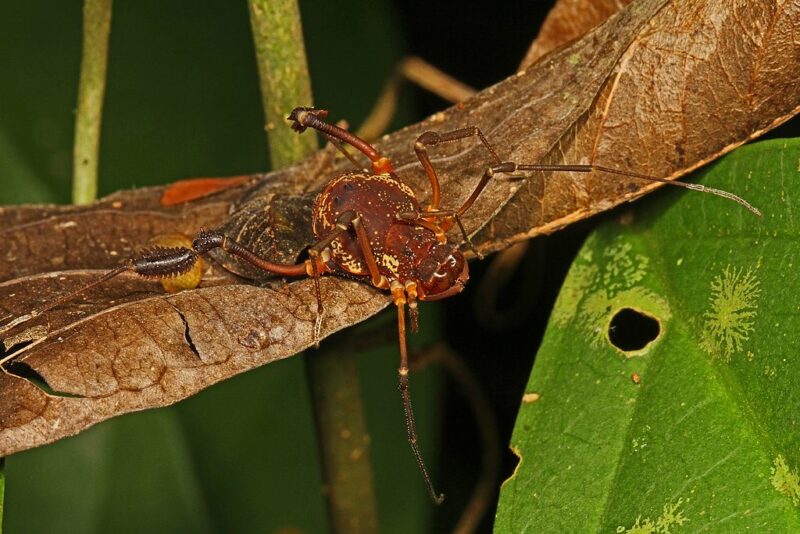
| Property | Value |
|---|---|
| Scientific Name | Various species |
| Average Size | Small (< 10 mm) |
| Diet | Detritivores, feed on decaying organic matter |
| Special Features | Arachnid similar to spiders with a distinct body shape |
The cave harvestman is a troglobite, a species that lives in underground holes and has tiny or nonexistent eyes, shortened limbs, and other adaptations to its subsurface habitat. This harvestman has lengthy legs, is blind, and is pale orange. The exoskeleton has a rough texture. The widely conical eye mound has a few tiny tubercles; the retina is missing, and the cornea is varied. The penis is spherical apically and has a ventral plate prong.
The Bone Cave harvestman possesses two dorsal, 17 lateral, and four ventral setae. It exhibits a slender and conical-shaped basal knob on the glans, while the peristylar lobes take on a claw-shaped form, with the central lobe being lengthy.
The stylus of the Bone Cave harvestman is long, curved, and ventrally carinate, featuring apical speculation. The basal fold is well-defined. Adults display a light orange coloration, while juveniles appear white to yellow. Geographic polymorphism is evident in this species.
Northern populations of the Bone Cave harvestman exhibit larger legs, a smoother exoskeleton, and reduced or absent corneas. This species exclusively inhabits underground environments throughout its entire life cycle. It is restricted to karst (limestone) formations, including caves, sinkholes, and other subterranean structures.
The Cave Harvestman is highly sensitive to humidity levels that are not fully saturated. While most individuals are typically found beneath large boulders, they are occasionally observed walking on damp surfaces. In particular, individuals are frequently discovered within the Temples of Thor Cave, situated on a steep slope approximately 32.8 yards (30 meters) from the entrance, in complete darkness.
Just from their name, they are deserving members of the top 10 cave animals
#8 Tumbling Creek Cave Snail

| Property | Value |
|---|---|
| Scientific Name | Antrobia culveri |
| Average Size | Very small (< 5 mm) |
| Diet | Algae and organic detritus |
| Special Features | Endemic to Tumbling Creek Cave in Missouri, USA |
The cave snail of Tumbling Creek is a tiny, white, blind aquatic snail. This snail is a troglobite, which means that it lives in caves. It’s also an aquatic troglobite, and stylolites or stygofauna are creatures that dwell in this unique type of environment.
In places with little or no silt in Tumbling Creek, the Tumbling Creek cave snail dwells on the underside of rocks.
It commonly inhabits the underside of rocks and gravel of various sizes, showing a preference for a solid rock substrate.
Observations conducted between March and August 2001 reveal that Antrobia culvert currently occupies only 23 meters of available stream habitat, constituting approximately 5% of the 457 meters of accessible, suitable habitat. In contrast, Tumbling Creek cave snails complete their entire life cycle in underground waters and manifest extreme sensitivity to changes in water quality and quantity.
Although our understanding of this cave snail’s biology remains limited, researchers believe it feeds on aquatic microfauna, particularly the minute bacterial film or “biofilm” that the cave snail appears to consume.
#9 Devil’s Hole Pupfish
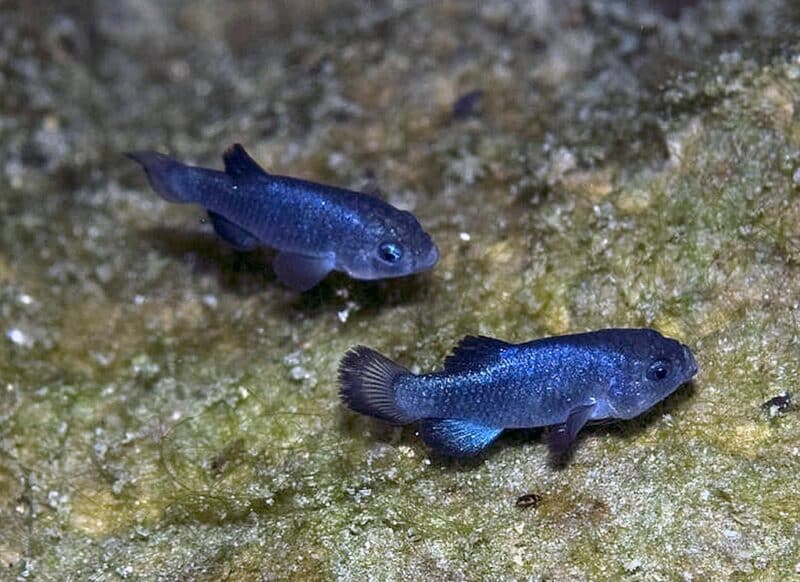
| Property | Value |
|---|---|
| Scientific Name | Cyprinodon diabolis |
| Average Size | Very small (2-3 cm) |
| Diet | Algae and small invertebrates |
| Special Features | Endemic to Devil’s Hole in Nevada, USA |
Meet the Devils Hole pupfish (Cyprinodon diabolis), a species teetering on the edge of extinction, dwelling exclusively within the confines of Devil’s Hole, a water-filled cavern nestled in Nevada. It shares kinship with C. nevadensis and the Death Valley pupfish, first acknowledged as a distinct species back in 1930, known as C. salinus.
The exact age of this species remains enigmatic, with estimates spanning from a mere one thousand to an astonishing sixty thousand years. Males sport a dazzling metallic blue hue, a stark contrast to the more yellowish tones exhibited by females and juveniles. This vivid coloration evolves with age and gender. A distinctive trait of the Devil’s Hole pupfish is the conspicuous absence of pelvic fins.
Within the confines of Devil’s Hole, these pupfish prove to be resourceful omnivores, making a meal out of practically every available food source, including beetles, snails, algae, and freshwater crustaceans. Their dietary preferences shift with the changing seasons. Adding an element of intrigue, Neoclypeodytes cancellous, a predacious diving beetle, was first discovered within Devil’s Hole in 1999 or 2000, preying on these pupfish.
Reproduction is a year-round affair, with peaks occurring during the spring and fall. However, female pupfish produce a limited number of eggs, and the journey from egg to adulthood is fraught with challenges, resulting in a relatively low survival rate. The lifespan of individual pupfish spans a mere 10 to 14 months.
Due to the confinement of their entire natural habitat to a single location, efforts to establish additional populations have been underway since the 1960s and 1970s, though many of these endeavors have met with limited success.
#10 Cave Crayfish
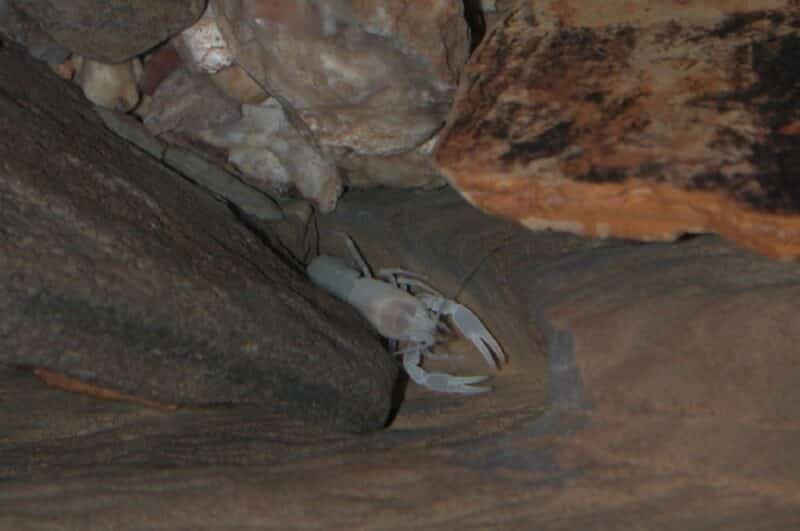
| Property | Value |
|---|---|
| Scientific Name | Various species |
| Average Size | Varies by species |
| Diet | Omnivorous (aquatic plants, insects, detritus) |
| Special Features | Adapted to underground aquatic environments in caves |
Introducing another remarkable resident of the top 10 cave-dwelling creatures: the cave crayfish. This diminutive, pale crayfish exclusively calls caves its home, boasting unique characteristics that set it apart.
Lacking pigmentation and equipped with diminutive eyes, this species navigates the dark caverns with remarkable adaptations. A distinguishing feature in males is a fully developed and hardened first pleopod, which serves as their reproductive appendage.
What truly sets these males apart from their close relatives, Cambarus setosus and C. Tartarus, is the absence of a transverse groove that separates the proximolateral lobe from the shaft on the first pleopod. Furthermore, distinguishing itself from C. zo phonates, it extends the central projection of the first pleopod further and features a shallow subapical notch.
While much about their reproductive behaviors and sociobiological data remains a mystery, they exhibit reproductive traits similar to other decapods. Males initiate their transition into the reproductive form in late summer, engaging in copulation during this period, typically late summer and early fall. Egg-laying is most likely to occur during late winter and early spring. Come April, the majority of males molt back into their nonreproductive state.
Life in the underground stream these crayfish inhabit is far from stable. The velocity and depth of the subterranean waters fluctuate, with some sections drying up, leaving only tiny puddles, while others may vanish underground without a trace. Occasional downpours can even lead to the cave filling with water, as evidenced by debris trapped near the cave roof during such events.
Summary of Cave Animals
These cave animals may be found in a deep, dark cave. They live in utter darkness for the majority of their lives. After all those years in the shadows, they’ve learned how to make the most of their home. Troglobites or troglophiles are animals that only survive in caves. Troglobites are cave dwellers who cannot thrive outside of their native environment.
On either hand, Troglophiles can survive outside of these caves, but they prefer to spend most of their life inside. We are amazed by the magnificence of caverns, home to various species. Some of these species have fascinating adaptations to survive in an environment without light and scarce food.
Caves are home to a diverse range of animal species from all over the world. We want to raise awareness about these fascinating creatures and the relevance of caves as their natural habitat. Because there is no sunshine in the cave, sight is uncertain. Because few plants can grow without light, finding food becomes a challenge. Based on the cave, conditions might be exceedingly cold or extremely hot.
If you want to learn more about animals, you can look at this article about the top 10 ugliest animals.
- Animals and Wildlife in Colorado - April 24, 2024
- Best Places to see Sloths - April 24, 2024
- Where to See Alligators in the Wild - April 24, 2024

